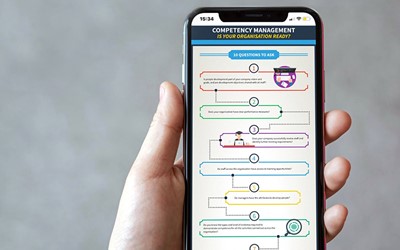How to write effective competency statements
To help you write effective competency statements it’s first useful to understand what a competency statement is and how you might use them.
A good question to have in mind is ‘what is the purpose of providing these competency statements?’
Posted 25 May 2022
What is a competency statement?
Competency statements (also known as competency definitions) describe the capabilities or behaviours required to carry out a specific task or function in a particular context. These are typically used in workforce development, and they play a key role in competency frameworks.
A competency definition usually includes:
- A title - often written to identify the context, i.e. Hazard Materials Handling
- A statement - to identify the behaviour or capabilities required to perform a task. This should include any conditions that might apply. i.e. Use hazardous materials according to Company health and safety regulations and workplace requirements.
- Some metadata - to organise, sort and reference the definition.
- A level of proficiency - to identify what expertise is required.
The definition should be able to be used on its own, be singular in its expected result, and able to work in combination with others in a competency framework. And each definition requires a unique identifier so it can be reused in many frameworks.
Why are competency statements important?
Competency statements help ensure that everyone in your organisation understands what is expected of them in their role. They support learning and development by providing a clear foundation for training content, and they help you assess whether your workforce has the required skills, behaviours and knowledge in place.
Well-crafted competency statements are also essential when developing frameworks for hiring, onboarding, performance evaluation and compliance tracking.
Competency statements vs learning outcomes
There’s often confusion between learning outcomes and competency statements – and while they can work together, they serve different purposes. Learning outcomes are typically broader and may include several competency definitions, as well as other elements like academic certifications or qualifications. Competency statements, on the other hand, focus on a single, specific behaviour or skill that’s required for effective performance.
When combined in a framework, competency definitions often describe the expectations of a particular job function or role in clear, actionable terms.
Competency statement writing models (air, star)
While there are several approaches to structuring competency statements, most are based on models like AIR (Action, Instruction, Result) or STAR (Situation, Task, Action, Result). In these models, the action is always expressed as a verb, while the instruction or task is the object of the verb. Together, they describe the actions to be taken and the outcome that should be achieved.
This helps ensure the statement is written clearly and consistently, making it easier to understand what’s required and how it can be assessed.
How to write effective competency statements
To help you create strong competency statements – whether you’re starting from scratch or revisiting existing ones – it’s helpful to go back to basics. A good question to begin with is: what is the purpose of providing these competency statements? Understanding how you’ll use them – whether in recruitment, training, performance management or compliance – will help guide the way you structure them.
Tips for writing effective competency statements
When you’re ready to start writing, there are a few key things to consider. First, make sure you fully understand the context – the situation or environment where the competency will be applied. This helps ensure your statements are relevant and practical.
You’ll also want to make sure your statements are:
- Clear and action-oriented, using verbs that match the level of expertise required
- Categorised appropriately as either knowledge, behaviour, or skill
- Specific and measurable, so the expected outcome is easy to evaluate
- Aligned with the context, so they reflect real-world expectations in your workplace
It’s equally important to have a method in place to evaluate whether the competency has been met. This ensures your statements are not just well-written, but meaningful and useful in practice.
Free eBook: The Pathway to performance
If you’re looking to understand more about the key considerations for implementing a competency tracking framework and how this will benefit your company, please download our Competency Management eBook, in which we share how you can use competency management as the pathway to performance.
And if you would like our help in writing competency definitions, please do get in touch.
Recent Posts
White-labelling: The secret to training learners actually trustTurning AI into potential gain
Seamless HR Integration: Streamlining workforce enrolment with eCom's eNet Product Suite
eCom Learning Solutions: Staying ahead in a constantly evolving landscape
Is your work changing, or just your tools? A question for the modern workforce


